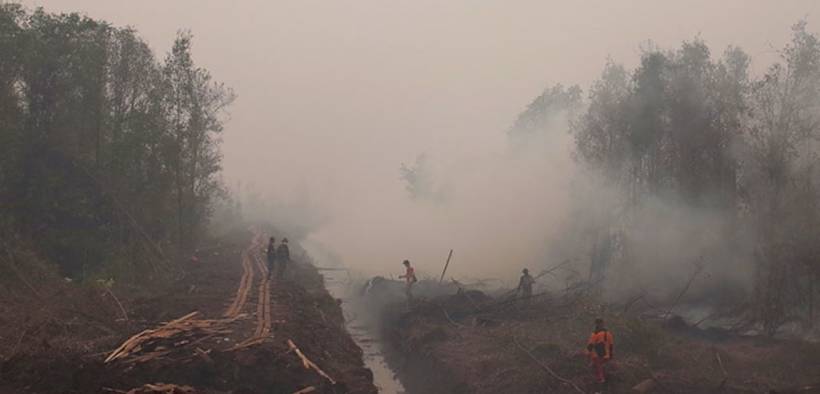Indonesia Fires Emitted Double the Carbon of Amazon Fires

Indonesian fires this year emitted nearly twice the amount of greenhouse gases as the forest fires that razed parts of the Brazilian Amazon, new research shows.
(By Hans Nicholas Jong, MongoBay) Fires from land and forest fires across Indonesia this year have pumped at least 708 million tons of greenhouse gases into the atmosphere — almost double the emissions from the fires that swept through the Brazilian Amazon this year.
That was the finding from researchers at the Copernicus Atmosphere Monitoring Service (CAMS), who noted that the Indonesian fires were one of the most intense in nearly two decades, unleashing far more than the 366 million tons of carbon dioxide equivalent (CO2e) churned out by the higher-profile fires in the Brazilian Amazon.
“What has stood out with the recent fires in Indonesia is how high the daily total fire intensity and estimated emissions [are] than the average of the previous 16 years,” Mark Parrington, a senior scientist at the CMAS who studies emissions from wildfires, told Mongabay.
Exacerbated by drier-than-usual weather patterns, this year’s fires have been the most severe since those in 2015, when 26,000 square kilometers (10,000 square miles) of land across Indonesia was razed. The fires back then cause an estimated $16 billion in economic losses, and the smoke they generated sickened half a million people.
But while greenhouse gas emissions from the 2015 fires were much higher — estimated at 1,385 million tons of carbon dioxide equivalent (CO2e) — emissions this September were comparable to four years earlier: 420 million tons of CO2e, compared to 478 million tons in September 2015.
“There were some days in August where the emissions were above the average but they have increased significantly since 1 September, and are comparable to the daily activity in August-September 2015,” Parrington said.
The intensity of the fires and the volume of emissions have since declined, with emissions in October standing at 119 million tons of CO2e, and 48 million tons during the first two weeks of November.

Comparison between Indonesia’s fire emission data from 2019 and 2015. Courtesy of CAMS.
Indonesia Fires and Emissions Reduction Goal
The carbon spike threatens to derail Indonesia’s commitment to slash its emissions by 29 percent by 2030, said Anggalia Putri Permatasari, a forest and climate researcher at the Madani Foundation for Sustainability, an NGO.
By the time the rainy season sets in, the country will likely be among the top of global emitters, similar to 2015, when the emissions from just six weeks of fires catapulted the country from the sixth-largest emitter in the world to the fourth-largest.
Since then, Indonesia has recorded three consecutive years of declining emissions, to the point where it was deemed eligible for the first payment out of a $1 billion fund pledged by Norway in 2010 to keep the Southeast Asian nation’s emissions from forest destruction in check.
Anggalia said the Indonesian fires this year were a setback that should serve as a wakeup call for Indonesia and its commitment to helping reduce global carbon emissions. The burning comes ahead of next year’s climate summit, where nations that committed to the Paris Agreement in 2015 will gather to assess how much they’ve been able to do and how much more they can do.
The aim is to have new carbon-cutting targets, ones that are much more ambitious than the Paris goals in order to limit global warming to 1.5 degrees Celsius (2.7 degrees Fahrenheit) above pre-industrial levels, rather than a long-held international goal of 2 degrees Celsius (3.6 degrees Fahrenheit).
In 2023, countries will collectively assess progress toward the purpose and goals of the Paris Agreement, a process known as the global stocktake, a crucial element of the climate agreement.
“What’s needed is to get ready for [forest fires in] coming years, seeing how we will start accounting [our efforts] in 2020 for the Paris Agreement,” Anggalia said. “And then in 2023, we will start the global stocktake. So it seems like we have to start mapping our land and forest fire emissions for the next five years to see what they will look like.”

Fires in peat land in Pedamaran of South Sumatra’s Ogan Komering Ilir district. Image by Nopri Isim/Mongabay-Indonesia.
Dense Carbon Storage
A key factor in the severity of the emissions this year and in 2015 is the large proportion of burned area that constitutes carbon-rich peatland: about a quarter of the total burned area this year, and about a third in 2015. In its biennial update report to the U.N. Framework Convention on Climate Change (UNFCCC) for 2015, Indonesia attributed the spike in emissions that year to the burning of peat fires.
The country is home to 36 percent of the world’s tropical forest peatlands. In the past, these areas were largely overlooked for farming by local communities and businesses as they weren’t as fertile as typical mineral soil.
“However, because of the demand for land, especially for large plantations like palm oil or pulp and paper, people are looking for all kinds of land that are available,” Helena Varkkey, a senior lecturer at the University of Malaya in Kuala Lumpur, who wrote a book in Southeast Asia’s haze problem, told the Australian Broadcasting Corporation (ABC).
That made peatlands attractive for plantation firms.
“Because usually there’s not much community on it and it’s really far away from cities, so it’s not really policed very well,” Varkkey said. “So these are lands that are easily available and once they get it, it’s just there for them to do what they want.”
To clear these areas for large-scale plantations, companies drain these peat forests, which are among the most carbon dense ecosystems on the planet.
Peatlands store on average 10 times more CO2 than other ecosystems, packed in the thick layers of semi-decayed plant material that can be up to 18 meters (60 feet) deep. Indonesia’s peatlands store an estimated 28.1 gigatons of CO2, according to a 2017 study, more than all the country’s upland forest.
When drained or burned, the peat decomposes and the stored carbon is unleashed into the atmosphere.
The act of draining a hectare of tropical peat for plantation development itself emits an average of 55,000 tons of CO2 every year, roughly equivalent to burning more than 6,000 gallons of gasoline.
The emissions associated with producing a ton of palm oil — Indonesia’s top export — grown on drained peatlands are 20 times higher than the emissions from burning a ton of gasoline. This high carbon intensity explains why the Indonesian fires this year have been far more harmful in terms of emissions than the Brazilian Amazon fires
And once peatland starts burning, the fire is virtually impossible to extinguish.
“Rather than combust like dry grasses and shrubs on mineral soils, peatland fires smolder, producing smoke and air pollution that is much worse than typical biomass burning,” the Earth Innovation Institute, a nonprofit, said in a recent blog post. “Because of this smoldering, it is also very hard to detect and put out peat fires, as they do not burn hot enough to be detected by satellites and can spread underground. To completely extinguish the fires, we must simply wait for rain.”
















Q. Why?
A. Overpopulation.
There are far too many people in the world. It is the root of nearly all the many grievous probkems of “civilazation”.